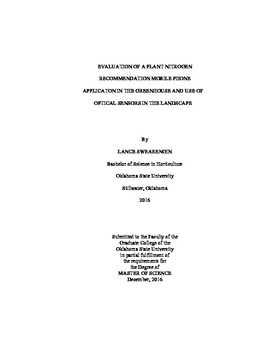| dc.contributor.advisor | Dunn, Bruce L. | |
| dc.contributor.author | Swearengin, Lance Wade | |
| dc.date.accessioned | 2018-06-29T14:41:11Z | |
| dc.date.available | 2018-06-29T14:41:11Z | |
| dc.date.issued | 2016-12-01 | |
| dc.identifier.uri | https://hdl.handle.net/11244/300379 | |
| dc.description.abstract | Use of a mobile phone application for iPhone that provides nutritional recommendations from optical sensors may give growers a quick reference for determining and effectively adjusting a crops nutritional status under a greenhouse production schedule but has not been tested. Stachys ‘Helene Von Stein’ and Verbena ‘Homestead Purple’ were supplemented with (0, 5, 10, 15, 20, and 25 g) of a 16N-3.9P-10K controlled release fertilizer (CRF) and tested up to 42 days after treatment (DAT). Hibiscus ‘Aphrodite’ and Clethra ‘Hummingbird’ were supplemented with (0, 10, 20, 30, 40, and 50 g) of the same 15N-3.9P-10K CRF. Plants were evaluated at 42 DAT on growth and plant quality measures including plant height, plant width, flower number, and dry weight. ‘Helene Von Stein’ and ‘Aphrodite’ responded favorably to the fertilizer recommendations provided by the mobile phone application as the treatment corrections produced favorable dry weights and flower numbers that were comparable to the highest performing fertilizer levels. A less substantial response was observed in the recommended treatment corrections for ‘Homestead Purple’ and ‘Hummingbird’ as the recommendations failed to produce dry weights and flower numbers in the corrected treatments that were similar to highest performing fertilizer levels. An accompanying field study was constructed to examine SPAD and atLEAF chlorophyll leaf sensor values on ornamental landscape plant materials grown under field conditions. Plants consisted of Forsythia ‘Lynwood Gold’, Hibiscus ‘Lavender Chiffon’, and Salvia ‘May Night’. ‘Lavender Chiffon’ values were not different from each other across all testing dates with the exception of the last testing date in October, and ‘Lynwood Gold’ sensor values were only observed to be different from each other in the July and October testing dates. ‘May Night’ values were not different from each other for each testing date with the exception of the last testing date in October. Leaf nitrogen values for ‘Lavender Chiffon and ‘Lynwood Gold’ showed a decreasing trend, while ‘May Night’ showed a stable trend over the course of the study. Significant environmental conditions played a substantial role in the field study results as record drought conditions plagued the region and supplemental irrigation was not used in the study. Significant correlations were observed between the SPAD and atLEAF sensor values in all species studied. | |
| dc.format | application/pdf | |
| dc.language | en_US | |
| dc.rights | Copyright is held by the author who has granted the Oklahoma State University Library the non-exclusive right to share this material in its institutional repository. Contact Digital Library Services at lib-dls@okstate.edu or 405-744-9161 for the permission policy on the use, reproduction or distribution of this material. | |
| dc.title | Evaluation of a Plant Nitrogen Recommendation Mobile Phone Application in the Greenhouse and Use of Optical Sensors in the Landscape | |
| dc.contributor.committeeMember | Moss, Justin Q. | |
| dc.contributor.committeeMember | Goad, Carla L. | |
| dc.contributor.committeeMember | Arnall, Daryl Brian | |
| osu.filename | Swearengin_okstate_0664M_14909.pdf | |
| osu.accesstype | Open Access | |
| dc.description.department | Horticulture | |
| dc.type.genre | Thesis | |
| dc.type.material | text | |
